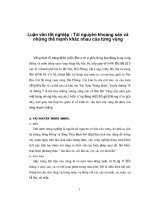the nordstrom way to Customer Service Excellence phần 1 ppt
Bạn đang xem bản rút gọn của tài liệu. Xem và tải ngay bản đầy đủ của tài liệu tại đây (359.53 KB, 29 trang )
TeAM
YYeP
G
Digitally signed by TeAM
YYePG
DN: cn=TeAM YYePG,
c=US, o=TeAM YYePG,
ou=TeAM YYePG,
email=
Reason: I attest to the
accuracy and integrity of
this document
Date: 2005.05.20
03:11:48 +08'00'
THE
NORDSTROM
WAY
to
Customer Service
Excellence
Also by Robert Spector
The Nordstrom Way:
The Inside Story of America’s Number One Customer
Service Company
Lessons from the Nordstrom Way:
How Companies Are Emulating the #1 Customer Service Company
Amazon.com: Get Big Fast
Inside the Revolutionary Business Model That Changed the World
Anytime, Anywhere:
How the Best Bricks-and-Clicks Businesses Deliver
Seamless Service to Their Customers
Category Killers:
The Retail Revolution and Its Impact on Consumer Culture
THE
NORDSTROM
WAY
to
Customer Service
Excellence
A
HANDBOOK FOR
IMPLEMENTING GREAT SERVICE
IN YOUR ORGANIZATION
R
OBERT
S
PECTOR AND
P
ATRICK
M
C
C
ARTHY
John Wiley & Sons, Inc.
This book is printed on acid-free paper.
Copyright © 2005 by Robert Spector and Patrick McCarthy. All rights reserved.
Published by John Wiley & Sons, Inc., Hoboken, New Jersey.
Published simultaneously in Canada.
No part of this publication may be reproduced, stored in a retrieval system, or transmitted in any form or
by any means, electronic, mechanical, photocopying, recording, scanning, or otherwise, except as permitted
under Section 107 or 108 of the 1976 United States Copyright Act, without either the prior written
permission of the Publisher, or authorization through payment of the appropriate per-copy fee to the
Copyright Clearance Center, Inc., 222 Rosewood Drive, Danvers, MA 01923, (978) 750-8400,
fax (978) 646-8600, or on the web at www.copyright.com. Requests to the Publisher for permission should
be addressed to the Permissions Department, John Wiley & Sons, Inc., 111 River Street, Hoboken, NJ 07030,
(201) 748-6011, fax (201) 748-6008.
Limit of Liability/Disclaimer of Warranty: While the publisher and author have used their best efforts in
preparing this book, they make no representations or warranties with respect to the accuracy or completeness
of the contents of this book and specifically disclaim any implied warranties of merchantability or fitness for a
particular purpose. No warranty may be created or extended by sales representatives or written sales
materials. The advice and strategies contained herein may not be suitable for your situation. The publisher is
not engaged in rendering professional services, and you should consult a professional where appropriate.
Neither the publisher nor author shall be liable for any loss of prof it or any other commercial damages,
including but not limited to special, incidental, consequential, or other damages.
For general information on our other products and services please contact our Customer Care Department
within the United States at (800) 762-2974, outside the United States at (317) 572-3993 or
fax (317) 572-4002.
Wiley also publishes its books in a variety of electronic formats. Some content that appears in print may not
be available in electronic books. For more information about Wiley products, visit our web site at
www.wiley.com.
Library of Congress Cataloging-in-Publication Data:
Spector, Robert, 1947-
The Nordstrom way to customer service excellence : a handbook for
implementing great service in your organization / Robert Spector and
Patrick D. McCarthy.
p. cm.
ISBN 0-471-70286-2 (pbk.)
1. Customer services—United States—Handbooks, manuals, etc. 2.
Nordstrom (Firm)—Management. 3. Department stores—United
States—Management. I. McCarthy, Patrick D. II. Title.
HF5415.5.S626785 2005
658.8′12—dc22
2004028848
Printed in the United States of America.
10987654321
In loving memory of my parents,
Fred and Florence Spector,
who taught me The Spector Way:
Work hard, be good, do well.
R. S.
In memory of Ray Black,
who first showed me The Nordstrom Way
P. McC.
Acknowledgments
T
he names on an author’s page cannot accurately reflect the
vast number of people who helped make this book possible.
As The Nordstrom Way has gone through several versions—in-
cluding two hardcover editions—more and more people have
made vital contributions.
For the original book, deep and heartfelt thanks to the
following:
Ⅲ Pat McCarthy for his belief in the Nordstrom way of doing
business.
Ⅲ
Bruce Nordstrom, Jim Nordstrom, John Nordstrom, and
Jack McMillan for their cooperation and trust, and for the
use of two privately published family histories, The Immi-
grant in 1887 by John W. Nordstrom, and A Winning
Team: The Story of Everett, Elmer & Lloyd Nordstrom by
Elmer Nordstrom.
Ⅲ
Elmer Nordstrom, John Whitacre, Ray Johnson, Jammie
Baugh, Len Kuntz, Barden Erickson, David Lindsey, Patrick
Kennedy, Bob Middlemas, Van Mensah, David Butler,
Kellie Tormey, and all the Nordstrom salespeople and man-
agers who put a human face on the company.
Ⅲ Betsy Sanders for her thoughtful reading of the manuscript.
For this book, I would like to thank:
Ⅲ
Bruce, Blake, Pete, and Erik Nordstrom for sharing their
insights in interviews with me.
VII
Ⅲ My deepest appreciation to Brooke White of Nordstrom for
her invaluable help in ensuring the integrity and accuracy of
this manuscript. She responded to every request with speed,
thoroughness, and good humor. Thanks also to Keli Fox and
Jeanne McKay.
Ⅲ Richard Narramore, my editor at John Wiley & Sons, shep-
herded this project with the utmost professionalism and gave
it an exciting new format for the twenty-first century.
Ⅲ Elizabeth Wales is the best agent (and friend) any author
could ask for.
Ⅲ My wife Marybeth Spector sustains me every day in every
way and is the ideal spouse for an author—at least this one.
R
OBERT
S
PECTOR
Seattle, Washington
ACKNOWLEDGMENTS
VIII
IX
Contents
Introduction xiii
P
ART
I: What Managers Can Do to Create
Nordstrom-Style Service 1
1 The Nordstrom Story: How a Century of Family
Leadership Created a Culture of Entrepreneurship,
Consensus, and Service 3
Exercise: What Is Our Company’s History? 22
2 Spreading the Service Culture: Publicly Celebrate
Your Heroes; Promote from Within 25
Exercise: Tell the Story of Your Company’s Heroes 37
Exercise: What Do We Stand For? 38
3 Line Up and Cheer for Your Customer: Create an
Inviting Place to Do Business 41
Exercise: You’re the Customer 65
Exercise: Call Your Company 66
Exercise: Surf Your Company’s Web Site 67
4 How Can I Help You? Provide Your Customers
with Lots of Choices 69
Exercise: Expand Your Customers’ Choices 84
P
ART
II: What Supervisors Can Do to Create
Nordstrom-Style Service 87
5 Nordstrom’s #1 Customer Service Strategy:
Hire the Smile 89
Exercise: Hiring Questionnaire 111
6 That’s My Job: Empower Employees to Act Like
Entrepreneurs to Satisfy the Customer 113
Exercise: What Does Empowerment Mean? 140
Exercise: Empowering Compensation 140
7 Dump the Rules: Tear Down the Barriers to
Exceptional Customer Service 141
Exercise: Examine Your Rules 154
8 This Is How We Do It: Manage, Mentor, and
Maintain Great Employees 155
Exercise: How Do We Develop Our Employees? 168
9 Recognition, Competition, and Praise: Create a
Sustainable, Emotional Bond with Your Employees 171
Exercise: Praising Your Employees 185
Exercise: Organize Recognition Meetings 185
Exercise: Make Your Company Special 186
Exercise: Goal Setting 186
Exercise: Customer Feedback: Letters 187
P
ART
III: What Employees Can Do to Create
Nordstrom-Style Service 189
10 Sell the Relationship: How Frontline Salespeople
Create Lifetime Customers 191
Exercise: Measuring Both Feet 209
Exercise: Tracking Spheres of Influence 209
Exercise: Rewarding Vendors and Suppliers 210
11 The Sale Is Never Over: Secrets of Nordstrom’s
All-Time Top-Performing Salesperson 211
Exercise: Create Your Own System 229
Exercise: Get Feedback from the Customer 230
12 Play to Win: Encourage Teamwork and Team
Competitions at Every Level of Your Organization 231
Exercise: Team Achievement 249
Exercise: Teamwork Requirements 250
Exercise: Ethical Behavior 250
Exercise: Ownership 250
Exercise: Heroics 251
Appendix Nordstrom Heroics: Inspirational Tales
of Teamwork and Legendary Customer Service 253
Notes 263
Index 265
CONTENTS
X
XI
Introduction
S
oon after Nordstrom opened a mammoth 330,000-square-
foot store in downtown San Francisco, a man purchased a
dress shirt at the Emporium, a competing department store that
was then adjacent to Nordstrom on Market Street, south of
Union Square. As he headed toward the exit, the sales clerk sud-
denly called out to the customer: “Wait! Stop!”
The puzzled customer wondered what the trouble was.
“Can I have your bag back?” pleaded the clerk. The compli-
ant shopper immediately handed the bag to the clerk, who pro-
ceeded to reach in, fish out the sales slip and scribble a quick
“thank you” on it. “Ever since Nordstrom came to San Fran-
cisco,” he complained, as he returned the bag to the customer,
“we have to do that.”
Seven years later, the Emporium was no more.
Fast forward to 2004. A female customer calls the Nordstrom
store in Salem, Oregon. She had driven past the mall and had
discovered when she got home that one of her hubcaps had fallen
off. “Was there anyone in Nordstrom,” she asked, “who could
check the road that ran past the mall to see if my hubcap was
there?” A Nordstrom employee did just that, found the hubcap,
brought it back to the store, washed it, and notified the customer,
who came in to pick it up.
“We love that story,” said Pete Nordstrom, executive vice
president of the company and president of its full-line stores,
“because it means people don’t just think of Nordstrom for buy-
ing things, they think of us as a place where they can find
solutions.”
INTRODUCTION
XII
Becoming the Nordstrom of Your Industry
At a time when customer service has become a core competitive
advantage for every kind of business, the Nordstrom department
store chain is the standard against which other companies and or-
ganizations privately (and often publicly) measure themselves.
Nordstrom has long been a popular subject for study among au-
thors of customer service books and educators at business gradu-
ate schools such as Harvard and Wharton. Roll Call, the
newspaper of Capitol Hill, once advised press aides for U.S. con-
gressmen to use the “Nordstrom approach” when trying to sell
producers of political talk-shows on the benefits of booking their
bosses. The New York Times Magazine quoted a minister in Bel
Air, California, who told his congregation in a Sunday sermon
that Nordstrom “carries out the call of the gospel in ways more
consistent and caring than we sometimes do in the church.”
Businesses of every kind strive to become the “the Nord-
strom” of their industry. A quick search on Google found that
the San Diego Union called Recreational Equipment Inc. “the
Nordstrom of sporting goods stores” and Specialty Foods mag-
azine described A Southern Season, a store in Chapel Hill,
North Carolina, as “the Nordstrom of specialty food.” Marty
Rodriguez, a top broker for Century 21, once told Fast Com-
pany, “I want people to think of me as the Nordstrom of real
estate.” A dean at Fullerton College in California vowed to cre-
ate “the Nordstrom of Admissions and Records.” According to
the Denver Post, the University of Colorado Hospital installed
a baby grand piano in the lobby and began advertising itself as
“The Nordstrom of Hospitals.”
You can find similar comparisons in yoga videos, office fur-
niture, public libraries, construction supply distribution, hot tubs,
Introduction
XIII
dental offices, pet stores, thermal rolls, garbage collection,
foundries, workplace giving, doors and windows, and contract
consulting.
Even Nordstrom uses this metaphor. In describing the com-
pany’s Nordstrom Rack division of clearance stores, Blake Nord-
strom said, “We like to think that the Rack is the Nordstrom of
the discount world.”
So, what does it mean to be the Nordstrom of your industry?
The obvious answer is it means you have a unique commitment
to customer service. How can an organization create a culture
and atmosphere to provide “Nordstrom-like” service? This book
answers those questions.
What Makes Nordstrom Unique?.
The chain, which is geared toward middle-to-upper income
women and men, offers its customers attractive stores, with a large,
varied, and competitively priced inventory of shoes, apparel, ac-
cessories, and cosmetics, and a liberal return policy. But many
stores do that—at least to varying degrees.
What makes Nordstrom unique is its culture of motivated,
empowered employees, each with an entrepreneurial spirit.
Nordstrom encourages, preaches, demands, and expects indi-
vidual initiative from these people who are on the frontlines;
people who have the freedom to generate their own ideas (rather
than wait for an edict from above) and to promote fashion
trends that are characteristic of that store and region of the
country. The best Nordstrom sales associates will do virtually
everything they can to make sure a shopper leaves the store a sat-
isfied customer.
INTRODUCTION
XIV
After all is said and done, the simplest explanation for what
makes Nordstrom Nordstrom is that Nordstrom salespeople put
themselves in the shoes of the customer. They do whatever they
can to make life easier for their customers.
All of us are experts on customer service because all of us—
at one point of the day or another—are customers. We know
good service when we see it, and we know bad service when we
see it. You don’t have to read a book to have it explained to you.
But a funny thing happens to people when they are in the
position of having to give service as opposed to getting service.
Suddenly, they forget about the Golden Rule, they forget about
empathy, they forget about the customer. When they are on the
other side of the sales counter or the telephone or the front desk
or the reception area, they think about the rules, the process, the
manual, the bureaucracy, the way it’s always been done. That’s
a recipe for terrible service. All of us customers only care about
who is going to take care of us; who is going to make our life
easier. That’s where Nordstrom comes in. Nordstrom people will
dowhateverittakes(withinreason,ofcourse)totakecareof
the customer.
When you discuss customer service with members of the
Nordstrom family, they frequently use a word that one rarely
hears in American business: humble.
“You need to be humble to do service,” said Erik Nord-
srom. “The moment you think you’re really good at it is when
you’re not really good at it. If you are connected to the cus-
tomer, the customer keeps you humble because we’re not per-
fect at it. If you are really looking to the customer, if you’re
really sensitive to the customer, and sensitive to the people on
the frontline, you are aware of your shortcomings. That keeps
Introduction
XV
us focused on the things that are necessary in order to give cus-
tomer service.”
When my book The Nordstrom Way was first published in
1995, it struck a chord with many companies in a variety of in-
dustries. Almost 100,000 copies and a second edition later, it
continues to serve as an inspiration for many different types of
businesses.
This book combines elements of The Nordstrom Way (par-
ticularly the brief history of the company) and a follow-up book
Lessons from The Nordstrom Way: How Companies Are Emu-
lating the #1 Customer Service Company. The latter book
showed how other companies in other industries were giving
Nordstrom-like service. (One of those featured companies, Con-
tinental Airlines, had been led by chairman and CEO Gordon
Bethune, who retired on December 31, 2004. Bethune is iden-
tified throughout this book as the former chairman and CEO,
however, it was his policies, leadership, and personality that
shaped the company.) This book expands on the principles that
were laid out in Lessons, and also adds implementation and train-
ing resources to help your organization become the Nordstrom
of your industry.
The Nordstrom Way to Customer Service Excellence is di-
vided into three sections.
Ⅲ
Part I: What Managers Can Do to Create Nordstrom-
Style Service looks at how an organization creates an iden-
tifiable and sustainable culture the way Nordstrom has done
it. Nothing can be accomplished without the culture. Also
in this section, we explore how organizations can create
“an inviting place” for their customers, whether in per
son,
INTRODUCTION
XVI
online or on the telephone; and how organizations can pro-
vide their customers with a variety of choices to satisfy
customers’ needs.
Ⅲ
Part II: What Supervisors Can Do to Create Nordstrom-
Style Service examines the area of influence of the people
closest to the employees. These responsibilities include hiring
the right people, then empowering, managing, mentoring,
praising, rewarding, and retaining those people. At Nord-
strom, frontline managers have the most important job in the
company because they do more than anyone else to transmit
the atmosphere and the culture to frontline employees.
Ⅲ Part III: What Employees Can Do to Create Nordstrom-
Style Service explores the role of employees in giving great
customer service, including developing and maintaining per-
sonal relationships, and encouraging both teamwork and in-
dividual achievement among their peers.
Nordstrom, as I always tell my audiences, is not the perfect
company. The perfect company has yet to be invented. In fact, in
the late 1990s, Nordstrom began to experience problems, as sales
dropped at stores opened at least one year (a key indicator in re-
tailing) and the stock fell as well. The opinion of the media was
summed up in a March 24, 1997 Time magazine double-page ar-
ticle that was headlined “Losing Its Luster.” It was accompanied
by a color photograph of a crushed Nordstrom gift box, wrapped
in tattered ribbon. During this period, Nordstrom suffered
through what might be called a crisis of confidence. The com-
pany spent millions of dollars on consultants.
By the fall of 2000, the Nordstrom board was looking for
new leadership. Although several well-known outside retail
ex
ecutives were interested in taking over the helm, the board
Introduction
XVII
selected Blake Nordstrom, then 39, and president of the com-
pany’s Nordstrom Rack clearance store division, to became pres-
ident of the company. Like their grandfather, father, uncles, and
cousins, Blake and his brothers Pete and Erik began working in
the store as young boys, sweeping the floor and stocking mer-
chandise at age 13. They worked their way up from selling shoes
on the floor to attaining executive positions. Pete became ex-
ecutive vice president of the company and president of the full-
line stores, and Erik was named vice-president of full-line stores.
Their father, Bruce, then 66, returned as chairman, a position he
shared with two cousins and a cousin-in-law until they all
stepped down in 1995. After a failed period of nonfamily man-
agement, the Nordstrom family was back in charge of the com-
pany. Although some analysts were disappointed by the selection
of Blake Nordstrom, the choice was cheered by Nordstrom in-
siders, from frontline salespeople to longtime managers, as a sig-
nal that the Nordstrom family was ready to rejuvenate the
company’s unique culture.
Blake, Pete, Erik, and Bruce toured stores, met with thou-
sands of Pacesetters (top salespeople) over a six-week period, and
were told that the company seemed to have lost confidence in its
sales leaders’ ability to inform management of problems on the
frontlines. Salespeople “felt maybe we didn’t trust them anymore
and we weren’t listening to them, that we didn’t value them as
much,” said Blake, who added that the old policy was “bottom
up management—where managers were there to facilitate sales
staff. But the company now had bosses who said ‘I am the man-
ager and I know all the answers.’ ”
“At the end, I felt strangely invigorated,” said Bruce. “These
are amazing folks. They were a little ticked off and certainly had
things to say. I felt so good about the amount of input I got.”
INTRODUCTION
XVIII
By going back to the basics, Nordstrom turned things
around. In 2004, the company recorded its fourth straight year
of improved sales and profits. The company continues to be the
most sought-after anchor store for mall developers because no
other anchor has the power to draw such a broad cross-section
of consumers. On August 19, 2004, a headline in the Wall
Street Journal announced “Nordstrom Regains Its Luster.”
With the help of this book, and the Nordstrom model, your
organization can create its own service “luster” by satisfying and
delighting your customers.
1
P
ART
I
WHAT MANAGERS
CAN DO TO CREATE
NORDSTROM-STYLE
SERVICE
P
art I, “What Managers Can Do,” examines the influ-
ence of the people who create, maintain, and support
the corporate service culture.
All employees, but especially managers, need to have an
appreciation and awareness of the company’s history and cul-
ture, which includes the guiding principles on which the or-
ganization was founded, as well as the trials and tribulations,
successes and accomplishments that the company has experi-
enced over the years.
In this part, we recognize the value of consciously spread-
ing a culture of service throughout the organization, including
among new hires. This part also explores how you and your
colleagues can provide your customers with more choices,
which will give your customers more reasons to do business
with your organization.
Nordstrom is a company whose managers constantly rein-
force its history, its culture, its reason for being, and its unwa-
vering dedication to think like the customer. This is the essence
of a great customer-service company.
THE NORDSTROM WAY
3
The Nordstrom Story
How a Century of Family Leadership
Created a Culture of Entrepreneurship,
Consensus, and Service
I know that the people who run the company are going to work as hard
or harder than me. The same principles that were here before I got here
will be in place after I retire. That’s encouraging. I really like that.
You can’t teach culture. You have to live it. You have to experience
it. You have to share it. You have to show it.
—Brent Harris,
Nordstrom’s national merchandise manager for shoes
1
5
A
rriving at the lobby of the Nordstrom corporate offices,
which is connected to the flagship store in downtown
Seattle, a visitor is greeted first by the Nordstrom history and
culture. On the walls adjacent to the elevators is a grainy, 100-
year-old picture of founder John W. Nordstrom and his original
partner, Carl F. Wallin, proudly standing outside their first tiny
shoe store; and another shot, circa 1910, of the interior of the
store, where mustachioed salesmen in rumpled suits are dwarfed
by stacks and stacks of shoe boxes that are collected along the
walls and piled high up to the ceiling.
New employees attend orientation on the fifth f loor of this
building, which contains the John W. Nordstrom room, where
the company holds its annual shareholders meeting, customer
events, staff meetings, and pep rallies. All around are pictures of
stores, various generations of Nordstroms, and numerous other
reminders of the rich Nordstrom heritage and culture. An ap-
preciation of what Nordstrom is all about cannot be fully grasped
without an understanding of the company’s culture. That’s why
the importance and the value of the culture are emphasized from
the moment new employees come to work for the company.
On one particular day, a dozen well-groomed and neatly
dressed men and women are seated behind a horseshoe configu-
ration of gray tables in a meeting room on the fifth f loor of the
WHAT MANAGERS CAN DO
6
corporate offices. They are a racially diverse group; most are
under the age of 30, a couple are closer to 50. What they have in
common is that they are all new employees, awaiting the start of
the one-day employee orientation that kicks off their career at
Nordstrom. In front of each one of them is a half-inch-thick blue
folder. The one word on the cover is “Welcome.”
On the inside, a separate sheet of paper contains these words:
As we travel along the road of life, we encounter paths that
lead to a great opportunity for growth. To recognize the
doors that open to a bright future is the key. Once inside, we
crave support from our colleagues. We know that the
health of our relationships is paramount to our own suc-
cess, and that the joy of sharing ideas leads to a diversity of
options. Our reward is access to a wealth of knowledge that
we would have otherwise overlooked. Welcome to Nord-
strom. Our door is open.
Inside the packet are separate folders containing information on
the company, employee guidelines, compensation program,
safety program, and employee benefits. There is also a 5
1
⁄
2-inch
by 7
1
⁄
2-inch card—the Nordstrom Employee Handbook. One side
of the card says:









